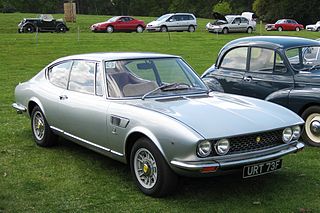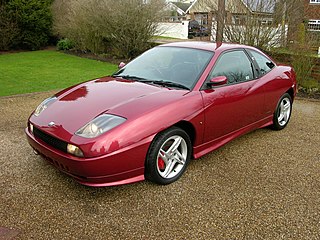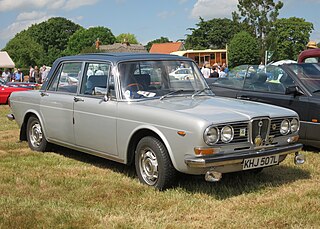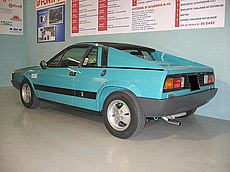
Abarth & C. S.p.A. is an Italian racing- and road-car maker and performance division founded by Italo-Austrian Carlo Abarth in 1949. Abarth & C. S.p.A. is owned by Stellantis through its Italian subsidiary. Its logo is a shield with a stylized scorpion on a yellow and red background.

The Fiat X1/9 is an Italian two-seater mid-engined sports car designed by Bertone and manufactured by Fiat from 1972–1982 and subsequently by Gruppo Bertone from 1982–1989.

The Fiat Punto is a supermini car (B-segment) produced by the Italian manufacturer Fiat from 1993 to 2018, spanning over three generations. The third generation of the car was marketed between 2005 and 2009 as the Grande Punto, and between 2009 and 2012 as the Punto Evo, until the single-word Punto name was reintroduced. As of May 2013, nearly nine million units had been sold globally.

The Fiat Dino was a front-engine, rear-wheel-drive sports car produced by Fiat from 1966 to 1973. The Dino name refers to the Ferrari Dino V6 engine, produced by Fiat and installed in the cars to achieve the production numbers sufficient for Ferrari to homologate the engine for Formula 2 racing.

The Fiat Coupé, officially also known as Coupé Fiat, is a car manufactured by Fiat between 1993 and 2000. The two-door, four-seater coupé was introduced at the Bologna Motor Show in December 1993 and features an exterior design by Chris Bangle at Centro Stile Fiat and an interior designed by Pininfarina.

The Lancia Fulvia is a car produced by Lancia between 1963 and 1976. Named after Via Fulvia, the Roman road leading from Tortona to Turin, it was introduced at the Geneva Motor Show in 1963 and manufactured in three variants: Berlina 4-door saloon, 2-door Coupé, and Sport, an alternative fastback coupé designed and built by Zagato on the Coupé floorpan.

The Lancia Flavia is an executive car produced by Lancia in Italy from 1961 to 1971. Production continued as the Lancia 2000 from 1971 to 1975.

The Lancia Rally was a mid-engine sports car and rally car built by Lancia in the early 1980s to compete in the FIA Group B World Rally Championship. Driven by Markku Alén, Attilio Bettega, and Walter Röhrl, the car won Lancia the manufacturers' world championship in the 1983 season. It was the last rear-wheel drive car to win the WRC.

The Lancia Beta was an entry-level luxury car produced by Italian car manufacturer Lancia from 1972 to 1984. It was the first new model introduced by Lancia after it had been taken over by Fiat in 1969.

The Fiat 124 Sport Spider is a convertible sports car marketed by Fiat for model years 1966–1985. Designed by and manufactured at the Italian carrozzeria Pininfarina factory, the monocoque, front-engined, rear-drive Sport Spider debuted at the November 1966 Turin Auto Show with styling by Tom Tjaarda.

The Autobianchi A112 is a supermini produced by the Italian automaker Autobianchi. It was developed using a shrunken version of the contemporary Fiat 128's platform. The mechanicals of the A112 subsequently underpinned the Fiat 127. It was introduced in November 1969, as a replacement for the Bianchina and Primula, and was built until 1986, when it made way for the more modern Autobianchi Y10. Over 1.2 million A112s were produced in Autobianchi's Milan factory.

The Fiat 850 is a small rear-engine, rear-wheel-drive car manufactured and marketed by Italian car manufacturer Fiat from 1964 to 1973.

The Lancia Kappa or Lancia k is an executive car manufactured and marketed by Italian manufacturer Lancia from 1994–2000, with saloon, estate, and coupé variants — sharing platforms with the Alfa Romeo 166. The Kappa has a front-engine, front-drive, five passenger, left-hand drive design.

The Lancia Gamma is an executive car manufactured and marketed by the Lancia subdivision of Fiat. Following its debut at the 1976 Geneva Motor Show as Lancia's new flagship, the Gamma was marketed as 4-door fastback saloon as the Berlina (1976-1984) and as 2-door coupé (1977-1984), both designed by Pininfarina — with 15,272 and 6,790 manufactured, respectively. The Gamma superseded the Lancia Flavia.

The Fiat 2300 is a six-cylinder executive car which was produced by Italian automotive manufacturer Fiat between 1961 and 1968. The 2300 was made as saloon, estate car and coupé. The 2300 saloon is noteworthy as in 1966 it became the first Fiat model to be available with an automatic transmission.
The Turin Motor Show was an auto show held annually in Turin, Italy. The first official show took place between 21 and 24 April 1900, at the Castle of Valentino, becoming a permanent fixture in Turin from 1938 having shared it with Milan and Rome until that time. From 1972, the show was held biannually and in 1984, it moved into Fiat's shuttered Lingotto factory.

The Lancia 2000 is a series of automobiles produced by Lancia between 1971 and 1975. It was the last vehicle designed by Lancia engineers before the marque's acquisition by Fiat in 1969. The Lancia 2000 was a direct evolution of the Lancia Flavia, which it replaced.

The Lombardi Grand Prix is a small, rear-engined sports car on Fiat 850 underpinnings. It was developed by the Carrozzeria Francis Lombardi with an in-house design by Giuseppe Rinaldi. The car was built from 1968 until 1972 and was also marketed as the OTAS 820, as a Giannini, and as the Abarth Grand Prix and Scorpione. It was first shown in March 1968, at the Geneva Motor Show. The design had a Kammback rear and a very low nose with flip-up headlights, and a large single windshield wiper. The pop-up headlights were electrically powered. The bodywork was all steel, except the rear panel. The design was originally shown as a prototype based on the front-wheel drive Autobianchi A112, and was adapted by Lombardi for the 850 sedan's floorpan. At Turin 1969 a targa version was also shown; called the "Monza", this open model has a rollover bar. At least two were built but it is unknown whether any were sold.

The Fiat Pininfarina Cabriolet was a two-door, two passenger, front engine rear drive convertible manufactured by Pinin Farina, and marketed by Fiat across two generations, superseding the Fiat 1200 Spider.
The Fiat Abarth 030, also known as Abarth SE 030, is a sports car racing prototype produced by Abarth in 1974, in collaboration with FIAT and Pininfarina.































